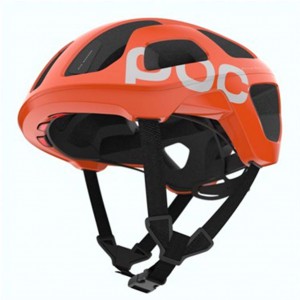Helmets are designed to help cyclists survive a crash – but what if they could prevent an accident in the first place?
That’s the idea behind a “wearable cycling tech concept” Volvo Cars is introducing at this year’s Consumer Electronics Show in Las Vegas. Developed in cooperation with protective sports gear maker POC and electronics giant Ericsson, the system would establish a two-way link between bicycle riders and vehicles, alerting both when there’s a chance of a collision.
While it’s unclear whether the system will go into production, it addresses an increasingly serious problem. Nearly 50,000 U.S. bike riders are killed or injured each year, a recent study by the Governors Highway Safety Association revealing that the annual death rate shot up 16% between 2010 and 2012 as more riders took to the roads, particularly on crowded urban streets.
“By exploring cloud-based safety systems, we are getting ever closer to eliminating the remaining blind spots between cars and cyclists and by that avoid collisions,” said Klas Bendrik, vice president and Group CIO at Volvo Cars

Volvo's new bicycle crash prevention helmet uses the internet to let cyclists and drivers know when they're in proximity to each other.
There’s a big push for so-called “connected cars” technology. A growing number of vehicles feature built-in WiFi and other external data links. These not only can be used to access infotainment technology, but also to connect a vehicle to a local infrastructure network, as well as to other vehicles, pedestrians and cyclists.
The Volvo system uses a smartphone app for bicyclists, such as the popular Strava, to monitor a rider’s precise location. That information is then sent to the cloud and compared to data from nearby vehicles.
“If an imminent collision is calculated, both road users will be warned – and enabled to take the necessary action to avoid a potential accident,” explains a Volvo release on the prototype system, noting the rider would see an alert light mounted on the helmet as well as feel a warning vibration.
(Volvo selling cars to the public via the internet. For more, Click Here.)
The driver, meanwhile, would see a warning flash on a head-up display, much the way many new vehicles now signal an alert when there’s a possibility of a frontal collision with another vehicle.
The proposed system would go beyond current crash detection systems, such as the Volvo City Safety technology, which use radar, lasers or cameras to watch out for potential obstacles. The two-way radio system would be able to spot a bike even when it was hidden in the vehicle’s blind spot, or approaching from a side street.
(Click Here for a list of 2014’s safest cars.)
So-called vehicle-to-vehicle and vehicle-to-infrastructure – or V2V and V2I – technologies are expected to significantly enhance automotive safety. The U.S. government recently announced a major test program covering about 100 miles of suburban Detroit roadways. The National Highway Traffic Safety Administration is considering making such equipment mandatory in the next few years.
(To see the impact cars are having on the Consumer Electronics Show, Click Here.)
Volvo is one of several carmakers studying ways to expand the application of V2V systems to protect bicyclists, motorcyclists and pedestrians, as well as vehicle passengers.
Honda has been exploring its own smartphone-based warning system, though it has not set out any plans for production yet.

